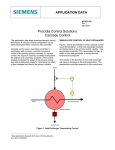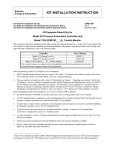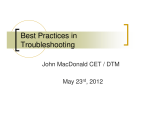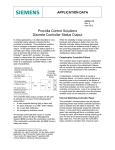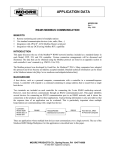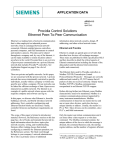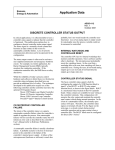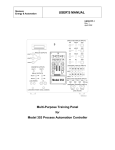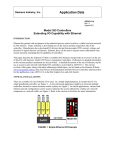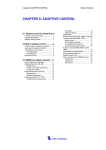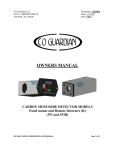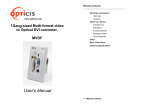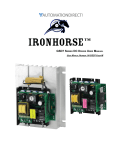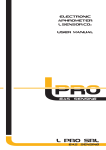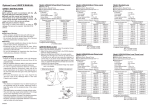Download Display - Siemens
Transcript
APPLICATION DATA AD353-119 Rev 2 April 2012 Procidia Control Solutions Digital Controller Tuning This application data sheet provides guidelines for tuning a modern digital controller, such as the Siemens Procidia™ 353 controller 1 . Tuning should be attempted only by a qualified person who is familiar with the process to be tuned and understands how to prevent the process from entering an unsafe condition during the tuning process. Many process control articles have addressed controller tuning. They frequently seem to imply that all control loops should be tuned for the fastest possible response. In fact, a control loop need only be tuned to meet the requirements of the process rather than to meet a preconceived idea of how fast a flow, pressure, or temperature loop should react. Tuning a control loop for the fastest response requires more work, increases the danger of oscillation with changing process conditions, and can induce interaction between the loops on a given process. Theoretical Tuning Criteria Control loop response to a setpoint or load change shows both the magnitude and duration of process deviation from the setpoint as criteria for evaluating the effect of controller tuning. One obvious criterion is the area of the response curve between the measurement and the setpoint line with the smallest possible area representing the best tuning. See Figure 1. Four minimum error integral tuning criteria that have been developed are listed below. These criteria are used, together with process simulations, primarily in the academic world for the purpose of studying controller algorithms. The first step in tuning a controller is determining the kind of response required to achieve optimum process operation. Controller Tuning Figure 1 Idealized Control Loop Response Controller tuning is the adjusting of the proportional gain, integral time, derivative time and in some cases, derivative gain to obtain the desired control loop response. Often, but not always, the desired response is either the fastest response to a setpoint change or the fastest return to setpoint after a load change. Control loop response can always be made slower by decreasing the proportional gain and increasing the integral time, but loop response can be made faster only up to the point where loop instability occurs. The object of most controller tuning methods is to obtain the fastest response consistent with stability requirements. a) Integral of the Absolute Value of the Error (IAE) IAE = ∫ b) Integral of the Square of the Error (ISE) ISE = ∫ See Applications Support at the back of this publication for a list of controllers. e2(t) dt c) Integral of the Time Weighted Absolutes Value of the Error (ITAE) ITAE = ∫ t|e(t)| dt d) Integral of the Time Weighted Square of the Error (ITSE) ITSE = 1 |e(t)| dt ∫ te2(t) dt AD353-119 The ISE tuning criterion [see b) above] puts more weight on large errors as compared with the IAE [see a) above]. The ITAE and ITSE are similar except they include a weight for elapsed time. Because of the uncertainties in process control loops, it is seldom possible or practical to meet even one of these criteria precisely. However, the ideas presented are useful in evaluating the suitability of a control response for a particular process. danger of continuous oscillation under changed process conditions. With a proportional only controller, quarter decay response comes close to meeting minimum area criterion. Therefore, it is only necessary to adjust the proportional gain to obtain a quarter decay response to be assured that the control response to an upset will be about as fast as practical. When integral and derivative modes are added, it is possible to obtain quarter decay responses with longer and shorter periods; quarter decay does not assure minimum area. It is necessary to find the right combination of controller adjustments to obtain optimum response. Fortunately tuning for an area criterion usually results in a response similar to quarter decay, so the desired degree of stability can be maintained. Loop Stability The effectiveness of controller tuning is also judged by the degree of stability of the loop response. For oscillatory responses, the degree of stability is indicated by the decay ratio (i.e. the ratio of successive peaks of the response). See Figure 2. A critical or even a highly damped response is employed on control loops where oscillation is undesirable, such as level control used for flow smoothing. Tuning for critical damping is not covered here. Ziegler-Nichols Tuning Methods The following tuning methods were developed through considerable experimentation and have become industry recognized methods for calculating controller adjustments from measurements made on the process. They are intended to yield quarter decay and reasonably fast response and are based on experience with typical processes. No specific tuning criterion is used. Figure 2 Loop Response, 1/4 Decay Ratio For non-oscillatory responses, the degree of stability can be expressed as the damping factor. A damping factor of 1 represents the fastest possible response without overshoot and is called critical damping. See Figure 3. A. Ziegler-Nichols Closed Loop Method 1. Bring the process to the desired setpoint on manual control. 2. Eliminate integral and derivative action by adjustment – maximum integral and minimum derivative times. 3. Adjust the proportional gain to the lowest setting and switch the control system to automatic. 4. Simulate a process upset by making a small momentary change in the setpoint. Look for a sustained cycle in the measurement on the controller output. If no cycle results, increase the proportional gain and try again. Repeat until a sustained cycle of continuous amplitude appears. 5. Note the lowest proportional gain at which cycling is sustained. This is the ultimate proportional gain PGu. 6. Time one complete process cycle, from positive peak to positive peak, in minutes. This is the ultimate period Tu. Figure 3 Loop Response, Critical Damping Quarter decay response is often used in tuning for process control simply because it represents a useful compromise between fast response and stability, and it includes a safety factor to reduce the possibility of continuous oscillation on a change in loop characteristics. A higher decay ratio (a ratio of 1 indicates continuous oscillation) would produce a more sustained oscillation and would increase the 2 AD353-119 7. Determine controller adjustments from the table below. be necessary to readjust the proportional gain, integral, or derivative to obtain the desired result. However, Ziegler-Nichols usually results in a response close to quarter decay so only minor readjustments should be necessary. Controller Tuning Constants TUNING TYPE OF CONTROLLER PARAMETER P PI PD* PID Proportional Gain 0.5 0.45 0.71 0.6 (PG) PGu PGu PGu PGu Integral --0.83 --0.5 (TI – minutes) Tu Tu Derivative ----0.15 0.125 Tu Tu (TD – minutes) * Not from the original Ziegler-Nichols Paper It is often found that PGu and Tu will change if tuning is repeated at a different setpoint or under different load conditions. This can occur as a result of nonlinearity in valves or transmitters or changing throughput in the process. Consequently, optimum control response can be attained only with a particular set of conditions and can be expected to change – to become slower or more oscillatory – as conditions change. This indicates the need for a safety factor in the controller tuning or the use of adaptive gain control. B. Ziegler-Nichols Open Loop Method 1. Bring the process to the desired setpoint on manual control. 2. Change the valve position a small amount ∆V (%). The change should be large enough to produce a measurable response in the process but not large enough to drive the process beyond the normal operating range. A 5% valve change is a good starting point. 3. Measure C and L (see Figure 4) on the process response curve. 4. Calculate: PGu = 2( ΔV ) ΔC Low Gain Tuning for Flow Control Although Ziegler-Nichols tuning may not work particularly well for flow control, this is not a serious problem. Flow control response, particularly liquid flow, is usually fast enough so that tuning by trial and error requires little time. One method is to set the proportional gain to a low setting (usually 0.2) and then adjust the integral time to obtain quarter decay or other desired response. Results should be close to any faster response obtained with a different combination of proportional gain and integral, and should be more than fast enough for most process requirements as satisfactory results are usually obtained with one setting. Tu = 4 L 5. Determine the controller settings from the previous table. Derivative Gain For a step change in the process variable, the derivative mode adds an impulse component to the controller output. The magnitude of the impulse is related to the derivative gain. The rate at which the impulse decays is related to the ratio of the derivative time and the derivative gain. The factory configured value for the derivative gain is 10 and does not normally need to be changed. The derivative mode is not recommended for “fast” control loops with “noisy” process signals (e.g. flow control). The derivative gain amplifies the noise component causing excessive activity in the controller output signal. However, it may be possible to use derivative on some “noisy” loops (e.g. temperature or level control) by reducing the derivative gain. This provides a “weak” derivative response that retains some of the benefit of the derivative mode while reducing the detrimental effects of the noise amplification. Figure 4 Process Response Curve C. Limitations Tuning constants listed in the table are based on experience with typical processes. A number of common processes may show non-typical responses, including liquid level and liquid flow control, but the tuning constants usually work fairly well. On any process the initial results of Ziegler-Nichols tuning may not produce quarter decay response and it may 3 AD353-119 In essence, the derivative gain provides a noise filter adjustment for the derivative mode. To increase the filter time constant, decrease the derivative gain. To achieve less filtering, increase the derivative gain the Siemens Internet site. See the navigation suggestion below. Application Support Automatic Tuning Controller User manuals for controllers and transmitters, addresses of Siemens sales representatives, and more application data sheets can be found at www.usa.siemens.com/ia. To reach the process controller page, click Process Instrumentation and then Process Controllers and Recorders. To select the type of assistance desired, click Support (in the right-hand column). See AD353-138 for a list of Application Data sheets. Many modern digital controllers have built-in automatic tuning capability. A number of methods for determining the process dynamics have been used. These include parameter estimation, recursive computation, and describing function analysis (reference ISA - Automatic Tuning of PID Controllers). The Siemens 353 controller includes automatic tuning based on describing function analysis. This method temporarily substitutes an ON/OFF control function, which includes hysteresis, for the PID function. The ON/OFF cycle period along with the gain of the measurement/valve are used with the describing function to determine the ultimate gain and ultimate period of the process. The controller uses these values to determine recommended P, I, and D settings. More information about the tuning method can be found in the User Manual for a Siemens 353 controller, e.g. UM353-1B, available on The tuning concepts in this publication can be applied to a: • • • • Model 353 Process Automation Controller Model 353R Rack Mount Process Automation Controller* i|pac™ Internet Control System* Model 352Plus™ Single-Loop Digital Controller* * Discontinued model i|pac, i|config, and 352Plus are trademarks of Siemens Industry, Inc. Other trademarks are the property of their respective owners. All product designations may be trademarks or product names of Siemens Industry, Inc. or other supplier companies whose use by third parties for their own purposes could violate the rights of the owners. Siemens Industry, Inc. assumes no liability for errors or omissions in this document or for the application and use of information in this document. The information herein is subject to change without notice. Siemens Industry, Inc. is not responsible for changes to product functionality after the publication of this document. Customers are urged to consult with a Siemens Industry, Inc. sales representative to confirm the applicability of the information in this document to the product they purchased. Copyright © 2012, Siemens Industry, Inc. 4




